Identifying control strategies to eliminate African swine fever in the United States swine industry in under 12 months
IF 2.2
2区 农林科学
Q1 VETERINARY SCIENCES
引用次数: 0
Abstract
The rising risk of African swine fever (ASF) introduction into the U.S., there is substantial emphasis on preparation for an epidemic to mitigate the economic impacts observed in previous outbreaks. Mathematical models represent a vital tool for simulating future epidemics and examining the effectiveness of response strategies. This study expands on our spatially explicit stochastic compartmental farm-level transmission model, PigSpread-ASF, to assess the effectiveness of the National Response Plan (NRP) and identify the control strategies necessary to eliminate ASF from domestic swine populations in the southeast U.S. in three, six, nine, and twelve months. We achieved this by incrementally increasing the intensity of the control actions i) quarantine and depopulation; ii) a 72-hour standstill; iii) contact tracing; and iv) control areas (composed of infected zones (3 km) and buffer zones (2 km) and surveillance zones (5 km), which include routine diagnostic testing, pre-permit testing and movement restrictions. For this model, ASF was deemed eliminated after three consecutive months of no new ASF cases following each time period, as determined by WOAH. Our results demonstrate that under the NRP, only 65.1 % of simulations in our study area were eliminated in a 12-month time frame. Through the analysis of 11 different scenarios, we propose that a future ASF control strategy would need to i) increase radii and duration of control areas and surveillance zones, ii) extend the traceback and quarantine for contact farms; iii) extend the movement standstill; iv) prohibit repopulation of depopulated farms; and v) quicker baseline detection of ASF, to eliminate ASF within three, six, nine and twelve months in the study area. The elimination of ASF in 12-months required buffer zone radius of 5 km and maintenance of the control areas and surveillance zones for 60 days, a traceback and quarantine of 60 and 30 days for the contact tracing, and a standstill of 30 days. In contrast, the three-month scenario required extension of the infected zone, buffer zone and surveillance zone radii to 20 km each and maintenance of the control area and surveillance zones for 90 days, a traceback and quarantine of 90 days for contact tracing, and a standstill of 90 days. By intensifying the current national response plan, ASF would likely be eliminated within 12-months of its introduction in the southeast U.S. However, it is pertinent to consider the limitations posed by resource capacities and the impact that intensifying control may have on business continuity.
确定控制策略,在12个月内消除美国养猪业中的非洲猪瘟
由于非洲猪瘟(ASF)传入美国的风险不断上升,因此必须对疫情做好准备,以减轻以往疫情中观察到的经济影响。数学模型是模拟未来流行病和审查应对战略有效性的重要工具。本研究扩展了我们的空间明确的随机区隔猪场水平传播模型,猪传播-非洲猪瘟,以评估国家应对计划(NRP)的有效性,并确定在3个月、6个月、9个月和12个月内从美国东南部的家猪种群中消除非洲猪瘟所需的控制策略。我们通过逐步加强控制行动的力度来实现这一目标:1)隔离和减少人口;Ii) 72小时的停工;Iii)接触者追踪;控制区(由感染区(3 公里)、缓冲区(2 公里)和监测区(5 公里)组成,包括常规诊断检测、许可前检测和行动限制。在该模型中,由世界卫生组织确定,在每个时间段之后连续三个月没有新的非洲猪瘟病例后,即视为消灭了非洲猪瘟。我们的结果表明,在NRP下,在12个月的时间框架内,我们研究区域只有65.1% %的模拟被消除。通过对11种不同情景的分析,我们提出未来非洲猪瘟控制策略需要:(1)增加控制区和监测区的半径和持续时间;(2)扩大接触农场的追溯和隔离;Iii)延长运动静止;Iv)禁止人口减少的农场重新繁殖;v)更快地基线检测非洲猪瘟,在研究地区的3个月、6个月、9个月和12个月内消除非洲猪瘟。在12个月内消除非洲猪瘟需要缓冲区半径为5 公里,控制区和监测区维持60天,追踪和隔离接触者分别为60天和30天,并暂停30天。相比之下,三个月方案要求将感染区、缓冲区和监测区的半径分别扩大到20 公里,并将控制区和监测区维持90天,为追踪接触者进行90天的追溯和隔离,并暂停90天。通过加强目前的国家应对计划,ASF可能会在美国东南部引入后的12个月内被消除。然而,考虑到资源能力带来的限制以及加强控制可能对业务连续性产生的影响是相关的。
本文章由计算机程序翻译,如有差异,请以英文原文为准。
求助全文
约1分钟内获得全文
求助全文
来源期刊

Preventive veterinary medicine
农林科学-兽医学
CiteScore
5.60
自引率
7.70%
发文量
184
审稿时长
3 months
期刊介绍:
Preventive Veterinary Medicine is one of the leading international resources for scientific reports on animal health programs and preventive veterinary medicine. The journal follows the guidelines for standardizing and strengthening the reporting of biomedical research which are available from the CONSORT, MOOSE, PRISMA, REFLECT, STARD, and STROBE statements. The journal focuses on:
Epidemiology of health events relevant to domestic and wild animals;
Economic impacts of epidemic and endemic animal and zoonotic diseases;
Latest methods and approaches in veterinary epidemiology;
Disease and infection control or eradication measures;
The "One Health" concept and the relationships between veterinary medicine, human health, animal-production systems, and the environment;
Development of new techniques in surveillance systems and diagnosis;
Evaluation and control of diseases in animal populations.
 求助内容:
求助内容: 应助结果提醒方式:
应助结果提醒方式:


